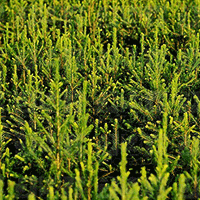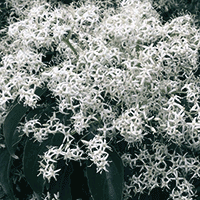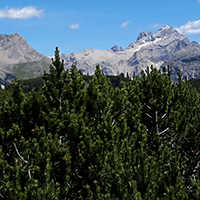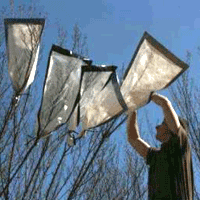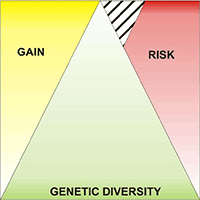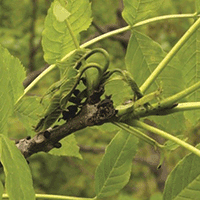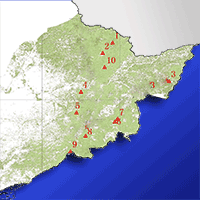
Preliminary study on genetic variation of growth traits and wood properties and superior clones selection of Populus ussuriensis Kom.
Jiaojiao Jin, Xiyang Zhao, Huanzhen Liu, Sui Wang, Ziwen Song, Xiaoyu Ma, Kailong Li
iForest - Biogeosciences and Forestry, Volume 12, Issue 5, Pages 459-466 (2019)
doi: https://doi.org/10.3832/ifor2991-012
Published: Sep 29, 2019 - Copyright © 2019 SISEF
Research Articles
Abstract
In this study the genetic variation of growth traits and wood properties was assessed in 45 clones of Populus ussuriensis Kom. grown in a 10-year-old experimental forest located in Northeastern China and a preliminary selection of superior clones was performed based on multi-trait selection index. The following traits were analyzed: tree height, H; diameter at breast height, DBH; volume, V; basic wood density, BWD; fiber length, FL; fiber length-width ratio, FL/W; microfibril angle, MA; cell wall percentage, CWP; fiber double wall thickness, FWT; vessel proportion, VP; wood fiber proportion, FP; wood ray proportion, RP; holocellulose content, HC. The results revealed significant differences (P<0.05) in DBH, V, BWD, FWT, VP and FP among different clones. Broad-sense heritabilities for growth traits and wood properties ranged from 0.020 to 0.749, therefore growth traits and wood properties are moderately or weakly controlled. Negative correlations between growth traits and most wood properties were also found. According to the multi-trait selection index at a selected rate of 10% and survival rates, 3 superior clones (I18, H16, C13) were selected, and the DBH, V, BWD, FL and FP of superior clones were higher than those of all clones by 2.83%, 9.81%, 3.40%, 6.59% and 0.31%, the MA, FWT, VP were lower than those of all clones by 7.54%, 0.39%, 2.12%, respectively. These superior clones could be used as starting breeding material for P. ussuriensis.
Keywords
Populus ussuriensis Kom., Growth Traits, Wood Properties, Genetic Variation, Multi-trait Index Selection
Authors’ Info
Authors’ address
Xiyang Zhao
Huanzhen Liu
Sui Wang
Ziwen Song
Xiaoyu Ma
Kailong Li
State Key Laboratory of Tree Genetics and Breeding, Northeast Forestry University, Harbin, 150040 (China)
Corresponding author
Paper Info
Citation
Jin J, Zhao X, Liu H, Wang S, Song Z, Ma X, Li K (2019). Preliminary study on genetic variation of growth traits and wood properties and superior clones selection of Populus ussuriensis Kom.. iForest 12: 459-466. - doi: 10.3832/ifor2991-012
Academic Editor
Fulvio Ducci
Paper history
Received: Nov 14, 2018
Accepted: Jul 18, 2019
First online: Sep 29, 2019
Publication Date: Oct 31, 2019
Publication Time: 2.43 months
Copyright Information
© SISEF - The Italian Society of Silviculture and Forest Ecology 2019
Open Access
This article is distributed under the terms of the Creative Commons Attribution-Non Commercial 4.0 International (https://creativecommons.org/licenses/by-nc/4.0/), which permits unrestricted use, distribution, and reproduction in any medium, provided you give appropriate credit to the original author(s) and the source, provide a link to the Creative Commons license, and indicate if changes were made.
Web Metrics
Breakdown by View Type
Article Usage
Total Article Views: 42670
(from publication date up to now)
Breakdown by View Type
HTML Page Views: 35989
Abstract Page Views: 3090
PDF Downloads: 2781
Citation/Reference Downloads: 2
XML Downloads: 808
Web Metrics
Days since publication: 2288
Overall contacts: 42670
Avg. contacts per week: 130.55
Citation Metrics
Article Citations
Article citations are based on data periodically collected from the Clarivate Web of Science web site
(last update: Mar 2025)
Total number of cites (since 2019): 5
Average cites per year: 0.71
Publication Metrics
by Dimensions ©
Articles citing this article
List of the papers citing this article based on CrossRef Cited-by.
References
Manual of quantitative genetics. Washington State University Press, Washington, USA, pp. 190.
Gscholar
Variation pattern of wood nature of planted Cunninghamia lanceolata. Journal of Northeast Forestry University 27 (5): 35-39.
Gscholar
Rapid prediction of wood stiffness from microfibril angle and density. Forest Products Journal 51 (3): 53-57.
Gscholar
Research on growth and wood properties joint genetic improvement of new clones of Populus deltoides (I-69) × P. euramericana (I-45). Journal of Nanjing Forestry University (Natural Sciences Edition) 25 (2): 6-10.
Gscholar
Selected mechanical properties of fast-growing poplar hybrid clones. Wood and Fiber Science 30 (2): 138-147.
Gscholar
Genetic variation of wood properties in balsam poplar (Populus balsamifera L.). Silvae Genetica 45 (2): 119-124.
Gscholar
Effect of planting density on timber density in Populus deltoides CL “Harvard”. Journal of Jiangsu Forestry Science and Technology 21 (1): 6-8.
Gscholar
Geography, climate variability regularity of Populus ussuriensis Kom. growth traits. Journal of Anhui Agricultural Sciences 42 (32): 11360-11362. 11373.
Gscholar
Variations of wood properties between plus-tree clones in Larix kaempferi (Lamb.) Carriere. Bulletin of the Forest Tree Breeding Center 21: 85-105.
Gscholar
The efficiency of early and indirect selection in three sycamore genetic tests. Silvae Genetica 34 (2-3): 72-75.
Gscholar
A study on wood physical and mechanical properties of thirteen poplar varieties. Shandong Forestry Science and Technology 2: 1-11.
Gscholar
Excellent clonal selection of Populus ussuriensis Kom. Inner Mongolia Forestry Investigation and Design 34 (2): 20-21.
Gscholar
Trees quantitative genetics. China Forestry Publishing House, Beijing, China, pp. 31-55.
Gscholar
Variation and heritability of wood density and fibre length of trembling aspen in Alberta, Canada. Silvae Genetica 33 (1): 11-16.
Gscholar
General situation of breeding and growth traits investigation of Populus ussuriensis Kom in the northeast. Forestry Science and Technology 40 (3): 27-29.
Gscholar
Flora of Heilongjiang. Northeast Forestry University Press, Harbin, China, pp. 138.
Gscholar
Genetic analysis and combined selection for growth and wood quality of open-pollinated families of Masson pine. Forest Research 7 (3): 263-268.
Gscholar

